The Four Main Plot Structures:
How many types plot structures are there and how are they used?
Hiya! Thanks for your question! Plot structures are important for creating a good story.
There’s an infinite amount of plot structures depending on the story you’re telling. Some types are better than others within certain genres. Here are the most common plot structures, and how they’re used:
The Four Main Plot Structures:
Freytag’s Pyramid:
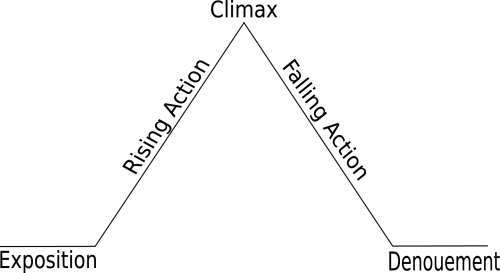
Also known as dramatic structure, this is the most simplistic of plot structures, and probably the one you were taught in elementary school. In this type of story structure, the climax falls in the middle, and the latter half of the story consists of falling action and the resolution. This was developed to analyze Greek and Shakespearian plays that use a five-act structure.
Why it’s good: It allows authors to explore the consequences of one’s actions. It’s also good for story analysis.
Why it’s bad: Long resolutions get boring fast. Modern novels don’t use this because no one wants to read a story where the villain is defeated in the middle.
When to use it: Children’s books and short stories
It’s good to use in children’s books because the goal of most children’s books is to teach kids a lesson. Using Freytag’s Pyramid gives writers the chance to teach kids the consequences of doing something wrong (lying, bullying, etc.). It works in short stories because the limited length prevents the denouement from being too long and boring the reader.
Examples: Any of Shakespeare’s plays
The Fichtean Curve:
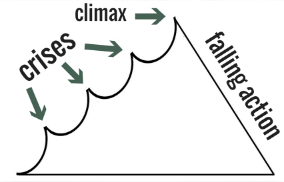
This is what most modern novels use, no matter the genre. The Fichtean Curve features a varying number of crises (or mini-climaxes) within the rising action to build up to climax about two-thirds of the way through the story. The falling action is short and used to wrap up loose ends or establish a new way of life for the characters.
Why it’s good: Putting crises throughout the story will keep readers hooked until the end. It also helps to keep good pacing. Despite being frequently used, this structure is loose enough that anyone can use it and make it unique for their own story.
Why it’s bad: Too much action can be overwhelming. This structure also doesn’t work well with certain story types such as Voyage and Return, Rebirth, or Comedy.
When to use it: Action-packed stories, Overcoming the Monster plots, or Quest plots
Examples: Night Circus by Erin Morgenstern, World War Z by Max Brooks, or Red Queen by Victoria Aveyard
The Hero’s Journey:
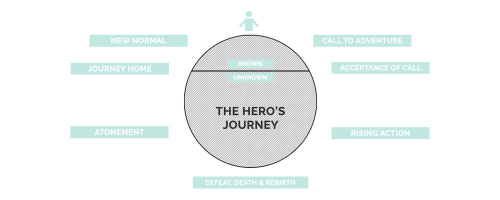
Another common plot structure that is seen in modern novels (especially western literature), and can be combined with the Fichtean Curve. Often, modern novels are a combination of the two. What makes the Hero’s Journey unique is that the protagonist must go through a literal or figurative death that completely transforms them. The death is usually, but not always, the climax of the story. Another key difference in The Hero’s Journey is that the protagonist must atone for their past rather than overcome it or move on without going back.
Why it’s good: Allows for great character development in character-strong stories.
Why it’s bad: Nearly every western novel, film, or TV show (successful and unsuccessful) uses this plot structure. It’s a little overdone, but if you can put a good personal twist on it, it can work out just fine.
When to use it: First-person stories, stories with small casts, Voyage and Return plots, or Rebirth plots
Examples: To Kill a Mockingbird by Harper Lee, The Lightning Thief by Rick Riordan, or Divergent by Veronica Roth
In Media Res
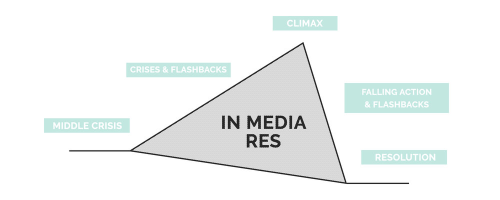
Latin for “in the middle of things”, In Media Res is a unique plot structure. Rather than start with an exposition that builds up to the action, In Media Res starts right in the middle of the story. If you were to start your story at the second or third crisis point of the Fichtean Curve, you would get In Media Res.
Why It’s Good: Dropping people in the middle of the action will hook the right from the beginning.
Why It’s Bad: Starting with the action can be disorienting for readers. Make sure you fill in the backstory as the plot moves on.
When to Use It: Stories with small casts, Crime plots, or Mystery plots
Examples: Hatchet by Gary Paulsen, The Lord of the Flies by William Golding, or The Iliad by Homer
There are plenty more plot structures, but these are the main four, and all others are based off these in some way. Keep in mind that most stories use a combination of these plot structures, so you don’t have to stick to just one.
Thanks again for your question! If you need help with anything else writing related, feel free to send in another ask. Happy writing!
- Mod Kellie
If you need advice on general writing or fanfiction, you should maybe ask us!
More Posts from Wandererklary and Others





Good luck! (ᵔᴥᵔ)
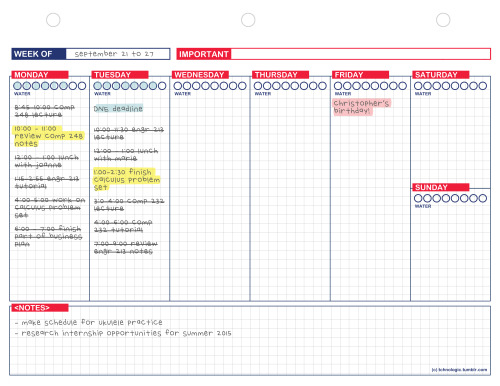
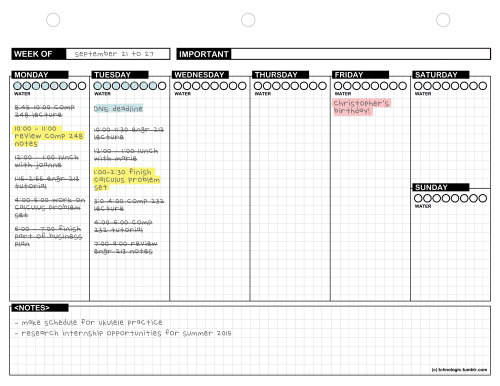
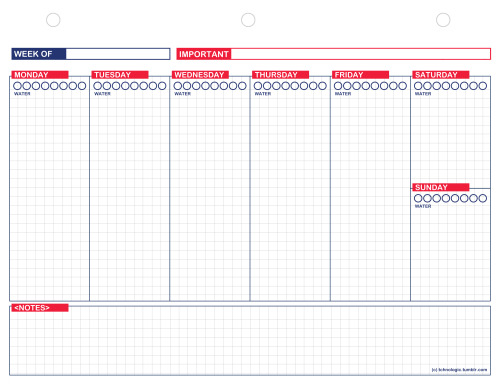
Weekly Planner Printable
I made this weekly printable schedule which you can download for free.
colour version
black and white version



I decided to try my hand at printables last night, and this is what I came up with! A simple little daily planner available in pink and grey. A5 size, reblog & right click to use!
Academic Writing Resources
General:
The Five-Paragraph Essay
Using Punctuation Marks
Deadly Sins Checklist
Formatting Your Paper
Writing About Literature
Basic Essay
Revision Checklist
Planning and Organization
Editing and Proofreading
Latin Terms
Essay Structure
Tips on Introducing Quotes
Academic Writing Tips
Introductions:
Introductory Paragraphs
Introductions
Writing an Introduction
Preparing to Write an Introduction
Introduction Strategies
The Introductory Paragraph
Writing Effective Introductions
In The Beginning
Introductions and Conclusions
The Introductory Paragraph
Writing Introductory Paragraphs
How to Write an Intro
Body Paragraphs:
Paragraph Development and Topic Sentences
Transitions
Transitions
Transitions
Four Components of an Effective Body Paragraph
Writing Paragraphs
Paragraph Development
Body Paragraphs
Body Paragraphs
Strong Body Paragraphs
Body Paragraphs
Writing Body Paragraphs
How to Write Body Paragraphs
Writing the Body
Writing Body Paragraphs
Body Paragraphs
Body Paragraphs that Defend a Thesis
How to Write Body Paragraphs
The Perfect Paragraph
Topic Sentences:
Topic Sentences
Writing Topic Sentences
Topic Sentences
Topic Sentences
The Topic Sentence
Paragraphs and Topic Sentences
The Topic Sentence
Topics, Main Ideas, and Topic Sentences
Writing a Good Topic Sentence
Good Topic Sentences
Conclusions:
Writing Effective Conclusions
Introductions and Conclusions
Conclusion Paragraphs
Conclusion Strategies
Conclusions
Tips for a Strong Conclusion
The Concluding Paragraph
Ending the Essay
Types of Conclusions
Writing a Strong Conclusion
How to Write a Conclusion
Writing Conclusions
Guide to Conclusions
Thesis Statements:
The Thesis Statement
Thesis Statements
Writing a Thesis Statement
Thesis Statement
Tips and Examples
Writing a Thesis
Writing the Thesis
How to Write Your Thesis
The Thesis
Thesis Statements
Guidelines for Writing a Thesis
Thesis Statements
Thesis
Thesis Statements
The Thesis
Create a Strong Thesis
How to Write a Thesis
Developing a Thesis
Guide to Writing Thesis Statements
Thesis Statements
Citing:
When to Cite
APA Documentation
MLA Documentation
Suggestions for Citing Sources
Research and Citation Resources
Citation Information
MLA Guidelines for Citing Poetry
MLA Style for Poetry
How to Format Your Paper
Argumentative Essays:
Argumentative Essays
Argument
Argumentative Essays
Persuasive or Argumentative Essays
Argumentative Essay
Argument/Argumentative
Argumentative Essays
How to Write a Good Argument
How to Write an Argumentative Essay
Writing Conclusions to Argumentative Essays
Argumentative Essay
Persuasive Essay Writing
Writing Concluding Paragraphs
Constructing the Argumentative Essay
Writing About Poetry:
Writing About Poetry
Writing About Poetry
Writing About Poetry Q & A
Poetry Explications
Writing About Poetry
Writing About Poems
Explicating a Poem
Writing About Poetry
Writing a Thesis Paper About a Poem
How to Start a Poetry Introduction
Poetry Essay Structure
Poetry Explication
Expository Essays:
Structure of a General Expository Essay
Expository Essay Examples
Sample Expository Essay
Expository Writing
Expository Essay Model
Elements of Expository Essays
Expository Writing Information
Expository Essays
Writing Expository Essays
How to Write an Expository Essay
Tips on Writing an Expository Essay
Expository Essays
Essay Map
Writing Expository Essays
How to Create a Strong Expository Essay
Expository Essay Writing
The Expository Essay
Research Papers:
How to Write a Research Paper in Literature
Writing a Research Paper
The Research Paper
How to Write a Research Paper
Five Paragraph Research Paper
Sample Research Paper
Writing a Research Paper
Tips for a Research Paper
How to Write a Research Paper
Writing a Scientific Research Paper
Writing Research Papers
Research and Writing
Research Papers that Rock
How to Write an Effective Research Paper
College Application Essays:
Application Essay Tips
Application Essays
Tips
10 Tips
Application Essays
How to Write a College Application Essay
Tips for an Effective Essay
Do’s and Don’t’s
College Application Essay
How to Write a College Application Essay
Narrative Essays:
Narrative and Descriptive
Narrative Essay Writing
The Personal Essay
Narrative Essays
Narrative Essays
Writing Narrative Essays
Narrative/Descriptive
Narrative Essay
Writing a Narrative Essay
Tips on Writing a Narrative Essay



Hello friends!
Studying for long important exams like the DAT (me (’: ), the MCAT, or even the SAT/ACT requires a lot of time budgeting! Today I was scheduling DAT studying for the next 20 days, and I realized that a progress percentage chart would be really useful for me because it would allow me to plan goals such as “finish a 1084-page review book” or “watch 46 chemistry videos from the video playlist” long-term! It’s hard to put long arduous tasks like these onto a daily or even weekly schedule - for me, they seem to work better when measured by %-finished.
I made this to use for myself this morning, and then realized that it might be useful for some of you out there, too! So I’ve uploaded it to google drive so you all can use it if it will be helpful in your studies. They come in blue, pink, yellow, and grayscale (for black-and-white printing): >>DOWNLOAD HERE<<
EDIT: I’ve gotten a suggestion from a very nice anon to make the background white so the printable does not use as much ink when printed in color! >>HERE<< is the link the white-background version on GDrive :)
To use this chart, I filled out specific goals on the left hand column and colored in the progress bar in the right in accordance with the percentage of the task or goal I had finished. I also marked dates next to the progress bar so I knew when I should have finished 50%, or 75%, or 100% of a task, etc. Here’s a pic of how I used it:
Keep reading
🙂

I don’t need to explain this post, do I?





Essay Guide and Planner Printable Pack
Today I published a helpful printable pack for essay writing! I decided to make printable versions of how I like to draft and organise all my notes for essays! I also wrote down a selection of tips and guidelines for getting an essay done and dusted!!
Download from this link :-)
*PS. You can get 10% using ‘student10′ at the checklist!*

Beauty must be appreciated. Cherish and admire the small things our earth gives. 😍

I believe in free education, one that’s available to everyone; no matter their race, gender, age, wealth, etc… This masterpost was created for every knowledge hungry individual out there. I hope it will serve you well. Enjoy!
FREE ONLINE COURSES (here are listed websites that provide huge variety of courses)
Alison
Coursera
FutureLearn
open2study
Khan Academy
edX
P2P U
Academic Earth
iversity
Stanford Online
MIT Open Courseware
Open Yale Courses
BBC Learning
OpenLearn
Carnegie Mellon University OLI
University of Reddit
Saylor
IDEAS, INSPIRATION & NEWS (websites which deliver educational content meant to entertain you and stimulate your brain)
TED
FORA
Big Think
99u
BBC Future
Seriously Amazing
How Stuff Works
Discovery News
National Geographic
Science News
Popular Science
IFLScience
YouTube Edu
NewScientist
DIY & HOW-TO’S (Don’t know how to do that? Want to learn how to do it yourself? Here are some great websites.)
wikiHow
Wonder How To
instructables
eHow
Howcast
MAKE
Do it yourself
FREE TEXTBOOKS & E-BOOKS
OpenStax CNX
Open Textbooks
Bookboon
Textbook Revolution
E-books Directory
FullBooks
Books Should Be Free
Classic Reader
Read Print
Project Gutenberg
AudioBooks For Free
LibriVox
Poem Hunter
Bartleby
MIT Classics
Many Books
Open Textbooks BCcampus
Open Textbook Library
WikiBooks
SCIENTIFIC ARTICLES & JOURNALS
Directory of Open Access Journals
Scitable
PLOS
Wiley Open Access
Springer Open
Oxford Open
Elsevier Open Access
ArXiv
Open Access Library
LEARN:
1. LANGUAGES
Duolingo
BBC Languages
Learn A Language
101languages
Memrise
Livemocha
Foreign Services Institute
My Languages
Surface Languages
Lingualia
OmniGlot
OpenCulture’s Language links
2. COMPUTER SCIENCE & PROGRAMMING
Codecademy
Programmr
GA Dash
CodeHS
w3schools
Code Avengers
Codelearn
The Code Player
Code School
Code.org
Programming Motherf*?$%#
Bento
Bucky’s room
WiBit
Learn Code the Hard Way
Mozilla Developer Network
Microsoft Virtual Academy
3. YOGA & MEDITATION
Learning Yoga
Learn Meditation
Yome
Free Meditation
Online Meditation
Do Yoga With Me
Yoga Learning Center
4. PHOTOGRAPHY & FILMMAKING
Exposure Guide
The Bastards Book of Photography
Cambridge in Color
Best Photo Lessons
Photography Course
Production Now
nyvs
Learn About Film
Film School Online
5. DRAWING & PAINTING
Enliighten
Ctrl+Paint
ArtGraphica
Google Cultural Institute
Drawspace
DragoArt
WetCanvas
6. INSTRUMENTS & MUSIC THEORY
Music Theory
Teoria
Music Theory Videos
Furmanczyk Academy of Music
Dave Conservatoire
Petrucci Music Library
Justin Guitar
Guitar Lessons
Piano Lessons
Zebra Keys
Play Bass Now
7. OTHER UNCATEGORIZED SKILLS
Investopedia
The Chess Website
Chesscademy
Chess.com
Spreeder
ReadSpeeder
First Aid for Free
First Aid Web
NHS Choices
Wolfram Demonstrations Project
Please feel free to add more learning focused websites.
*There are a lot more learning websites out there, but I picked the ones that are, as far as I’m aware, completely free and in my opinion the best/ most useful.
-
 heckcareoxytwit liked this · 5 months ago
heckcareoxytwit liked this · 5 months ago -
 kestimac liked this · 6 months ago
kestimac liked this · 6 months ago -
 heckcareoxytwit reblogged this · 6 months ago
heckcareoxytwit reblogged this · 6 months ago -
 auroraescritora liked this · 6 months ago
auroraescritora liked this · 6 months ago -
 neptunethefool reblogged this · 7 months ago
neptunethefool reblogged this · 7 months ago -
 princeoftherunaways liked this · 8 months ago
princeoftherunaways liked this · 8 months ago -
 kohitsuji liked this · 8 months ago
kohitsuji liked this · 8 months ago -
 avidrambling reblogged this · 10 months ago
avidrambling reblogged this · 10 months ago -
 avidrambling liked this · 10 months ago
avidrambling liked this · 10 months ago -
 brunofneves liked this · 11 months ago
brunofneves liked this · 11 months ago -
 zackember liked this · 11 months ago
zackember liked this · 11 months ago -
 kingsandthings reblogged this · 11 months ago
kingsandthings reblogged this · 11 months ago -
 kingsandthings liked this · 11 months ago
kingsandthings liked this · 11 months ago -
 kimyoonmiauthor reblogged this · 11 months ago
kimyoonmiauthor reblogged this · 11 months ago -
 xsultangalois liked this · 11 months ago
xsultangalois liked this · 11 months ago -
 poptipkutusu liked this · 1 year ago
poptipkutusu liked this · 1 year ago -
 heckcareoxytwit reblogged this · 1 year ago
heckcareoxytwit reblogged this · 1 year ago -
 heckcareoxytwit reblogged this · 1 year ago
heckcareoxytwit reblogged this · 1 year ago -
 monofpoke4life reblogged this · 1 year ago
monofpoke4life reblogged this · 1 year ago -
 monofpoke4life liked this · 1 year ago
monofpoke4life liked this · 1 year ago -
 writing-resources-sarchive reblogged this · 1 year ago
writing-resources-sarchive reblogged this · 1 year ago -
 newdawnhorizon reblogged this · 1 year ago
newdawnhorizon reblogged this · 1 year ago -
 audreycecilemoore reblogged this · 1 year ago
audreycecilemoore reblogged this · 1 year ago -
 iwillhaveamoonbase liked this · 2 years ago
iwillhaveamoonbase liked this · 2 years ago -
 honeyscript reblogged this · 2 years ago
honeyscript reblogged this · 2 years ago -
 raynethescribe reblogged this · 3 years ago
raynethescribe reblogged this · 3 years ago -
 invincibleweasel liked this · 3 years ago
invincibleweasel liked this · 3 years ago -
 lilxmcrtes reblogged this · 3 years ago
lilxmcrtes reblogged this · 3 years ago -
 chelonianmobile liked this · 3 years ago
chelonianmobile liked this · 3 years ago -
 nance-drew liked this · 3 years ago
nance-drew liked this · 3 years ago -
 vvinedarksea reblogged this · 3 years ago
vvinedarksea reblogged this · 3 years ago -
 furryous-derp reblogged this · 3 years ago
furryous-derp reblogged this · 3 years ago -
 imaginarywhispers reblogged this · 4 years ago
imaginarywhispers reblogged this · 4 years ago -
 hopefulmelodys liked this · 4 years ago
hopefulmelodys liked this · 4 years ago -
 quillington reblogged this · 4 years ago
quillington reblogged this · 4 years ago -
 giadesstrin liked this · 4 years ago
giadesstrin liked this · 4 years ago -
 arekives reblogged this · 4 years ago
arekives reblogged this · 4 years ago -
 supernalspirits reblogged this · 4 years ago
supernalspirits reblogged this · 4 years ago -
 roguesaintjack reblogged this · 4 years ago
roguesaintjack reblogged this · 4 years ago -
 story-character-art-reference reblogged this · 4 years ago
story-character-art-reference reblogged this · 4 years ago -
 thefadingremnant reblogged this · 4 years ago
thefadingremnant reblogged this · 4 years ago -
 lorislost liked this · 4 years ago
lorislost liked this · 4 years ago -
 le-zigui liked this · 4 years ago
le-zigui liked this · 4 years ago -
 girlyflame liked this · 4 years ago
girlyflame liked this · 4 years ago
